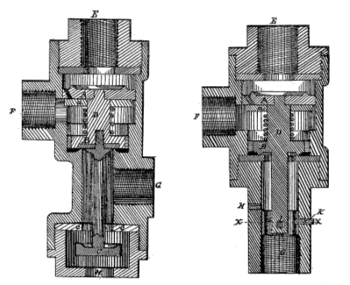George Westinghouse
June 16, 2016
As
Mark Twain supposedly said, "I have never let my
schooling interfere with my
education." However, the evidence for Twain's saying this is slight, and it's thought that the attribution should be to
novelist and
essayist,
Grant Allen.[1]
No matter who said it, it appears to have held true for many notable individuals, including
Bill Gates, a
self-taught computer programmer, and a famous
Harvard University drop-out. About a
century earlier than Gates,
George Westinghouse, Jr., (1846-1914) dropped out of
Union College (Schenectady, New York) in his first term to create a series of
inventions and an
industrial empire.
Westinghouse was born in
Schoharie, New York, quite near to
Schenectady and Union College. His father, George Westinghouse, Sr., owned a
machine shop where the younger George became adept at
designing and making
machinery. After spending some time in
military service in the
New York National Guard and the
New York Cavalry during the
Civil War, he found service in the
US Navy as an
engineer on a
gunboat through the war's end.
It was after the war, in 1865, when he returned to civilian life, that he attended Union College for that short period. At that point, he began his career as an inventor, inventing
steam-powered engines, such as the
Westinghouse Farm Engine, and railroad equipment.[2] As I wrote in a
previous article (Bacterial Signature, November 12, 2015), steam engines of all sorts were ubiquitous in that period, as were
steam locomotives in
rail transport.
In 1869, after seeing a
train wreck caused by the primitive
braking system used at the time in which brakes were local to each rail car and not centrally controlled, Westinghouse invented his
compressed air braking system for rail cars. As detailed in his 1873
patent (see figure), a locomotive engineer could apply brakes to all rail cars simultaneously.
 | Figures one and two from US Patent No. 144,006, 'Improvement in steam and air brakes,' by George Westinghouse, Jr., October 28, 1873.
(Via Google Patents.[3]) |
The system had a
safety feature in which the compressed air actually disengaged the brakes, so any failure of the compressed air supply would result in immediate braking. These brakes, which became ubiquitous on rail cars, were manufactured and sold by the
Westinghouse Air Brake Company. Westinghouse leveraged his railroad connections to produce and market other railroad devices, such as
railway signals. He founded the
Union Switch & Signal Company to manufacture and sell such devices.
After
Edison's perfecting the
incandescent light bulb and building the first
electric power station in
lower Manhattan in the period 1879-1882, Westinghouse realized the
commercial importance of
electrical technology. Seeing that he could make more money by developing a potentially better
alternating current (AC) electric system to compete with Edison's
direct current (DC) system, he hired
physicist,
William Stanley, to investigate AC circuitry in Pittsburgh. I wrote about the advantages of AC power distribution in reducing
power losses in transmission lines in a
previous article (Ionized Air, July 9, 2015).
Westinghouse and Stanley installed their first AC power system in
Great Barrington, Massachusetts, in 1886. Power was derived from a 500
volt hydroelectric generator stepped up by
transformer to 3,000 volts for transmission. At the end of the transmission line, transformers stepped the voltage down to 100 volts to supply
electric lights. The year, 1886, also marked the founding of the Westinghouse Electric & Manufacturing Company. The company name was shortened to
Westinghouse Electric Corporation in 1889.
Any article about AC power systems must mention
Nikola Tesla. Westinghouse
licensed Nikola Tesla's US patents for
induction motor and transformer designs in 1888. This was followed by AC lighting of the
1893 World's Columbian Exposition in
Chicago, for which Westinghouse outbid Edison's
General Electric. The Columbian Exposition demonstration was an important factor in the decision to have Westinghouse build the
Adams Power Plant at
Niagara Falls in 1895.
Westinghouse had close ties to the city of
Pittsburgh, Pennsylvania, having moved there in 1869 and eventually living in the
Homewood section of the city. Brady Smith, senior communications manager of the
Heinz History Center (
www.heinzhistorycenter.org) recalls several details of his life there in a recent article.[4] Since he had been a working man at his father's company, he understood the drudgery of the customary six day
work week, so in 1881 he gave his
employees a half-day off on
Saturdays.[4]
Natural gas wells in
Pennsylvania are not just a modern phenomenon associated with
fracking. Westinghouse drilled a gas well in his backyard in 1884 so he could have a supply of that
fuel for
experiments. As a result, he founded the first commercial gas company in Pittsburgh.[4] Westinghouse lost control of Westinghouse Electric after the
financial crisis of 1907, and by 1911 his
health was failing, and he was no longer active in business.[4]
At his death in 1914, Westinghouse left a legacy of 60 founded companies with 15,000 patents and 50,000 worldwide employees.[4] His
boyhood home in Schoharie, New York, is listed on the
National Register of Historic Places.
References:
- Never Let Schooling Interfere With Your Education - Mark Twain? Grant Allen?, Quote Investigator, September 25, 2010.
- According to Wikipedia, Henry Ford enjoyed working with a Westinghouse Farm Engine on a farm, and he even worked as a mechanic for these farm engines for the Westinghouse Company.
- George Westinghouse, "Improvement in steam and air brakes," US Patent No. 144,006, October 28, 1873.
- Brady Smith, "Let's learn from the past: George Westinghouse," Pittsburgh Post-Gazette, April 21, 2016.
- George Westinghouse Biography, Engineering and Technology History Wiki.




